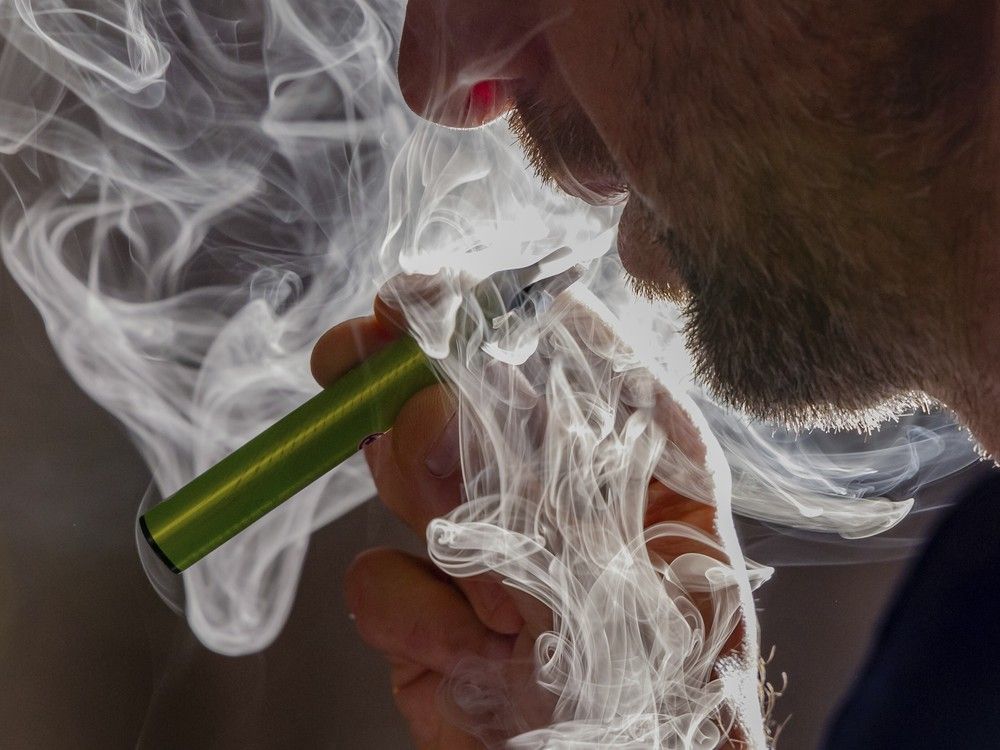
B.C’s NDP government has introduced a law aimed at holding manufacturers and wholesalers accountable for deceptive marketing practices and health impacts from vaping.
Here’s some information on the rise of vaping, the creation of new products like nicotine pouches you suck on and who is taking up vaping in B.C.:
WHAT IS VAPING?
Vaping uses an electronic device to convert liquid containing the drug nicotine into vapour that is then inhaled. Legal vaping liquid can’t contain more than 20 milligrams/millilitres of nicotine.
WHO IS VAPING?
The federal government’s 2022 Canadian Tobacco and Nicotine Survey shows that 13 per cent of youth in Canada had vaped in the previous 30 days. In B.C., vaping rates are higher, with 16 per cent of youth aged 15 to 19 having vaped in the past 30 days.
A person must be 19 or older to purchase tobacco or vaping products in B.C. There are an estimated 1.9 million Canadians that use vaping products.
Vaping products are sold widely throughout Metro Vancouver and B.C. through hundreds of stores.
WHAT REGULATIONS ARE IN PLACE?
The sale and use of vaping devices in B.C. is controlled by the Tobacco and Vapour Products Control Act . This law prohibits the sale of vaping items in hospitals or on university campuses, but doesn’t restrict sales close to or alongside schools.
Use of vaping products are banned on school property, with the school principal to blame if this occurs. The principal can use as a defence that they exercised reasonable care and diligence to prevent a contravention of the law.
In February last year, the B.C. government addressed the emergence of buccal nicotine pouches that are sold under brand names like Zyn and Zonnic and are gaining popularity among adults and youth.
These flavoured packages are placed in the mouth and are supposed to aid people trying to quit smoking and come in differing strengths up to six milligrams (the equivalent of six cigarettes).
The B.C. government has restricted the sale of these pouches. They must be sold by pharmacists only, and kept behind the counter.
“Regulating addictive and harmful products can protect young people from peer pressure, advertising or poor decisions. By putting addictive nicotine products behind the pharmacy counter, we can ensure these products are only sold to the people they’re intended for,” B.C. Premier David Eby said at the time.
Related
WHAT ABOUT THE NEW LAW
Attorney General Niki Sharma says the proposed Vaping Product Damages and Health Care Costs Recovery Act is modelled after similar laws the government used to sue tobacco companies and opioid manufacturers. It’s the first of its kind in Canada.
Sharma says some vaping companies have “engaged in deceptive practices to boost their profits” by marketing their products as safe and sometimes even beneficial, often targeting impressionable youth despite “knowing full well how untrue their claims are.”
Sharma says vaping has been gaining traction in Canada, especially among young people, and its popularity threatens to reverse declining tobacco use, “one of the most important public health achievements of the recent past.”
She says B.C. risks losing a “whole new generation to nicotine addiction.”
WHO SPEAKS IN FAVOUR OF VAPING?
There is a group called the Canadian Vaping Association that isn’t funded by tobacco companies and has as its goal the protection of the legal vaping industry and the promotion of sustainable growth. It has as one of its pillars protecting youth from vaping and supporting harm reduction, arguing smoking nicotine is worse than vaping.
The group’s last news release was issued on May 30 (World Vape Day), saying youth vaping is in decline according to Statistics Canada’s 2025 Health Survey on Children.
With files from The Canadian Press